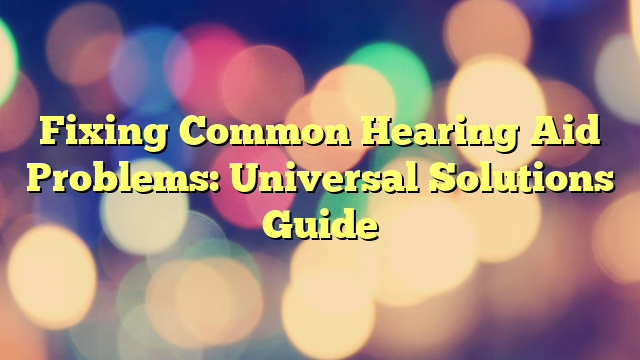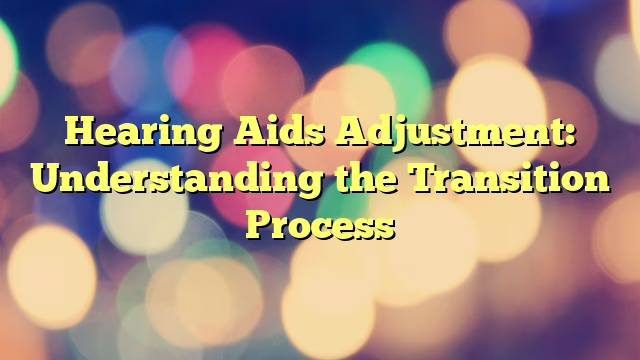Completely-in-Canal Hearing Aids: Your Essential Guide

Last Updated on 23/12/2025 by Admin
Comprehensive Guide to Completely-in-Canal Hearing Aids
Understanding Completely-in-Canal Hearing Aids: What Are They?
Completely-in-canal hearing aids represent a sophisticated solution designed to fit snugly within the ear canal, providing a compact and unobtrusive auditory aid. These devices are tailored to amplify sound effectively, appealing particularly to those who value both aesthetics and comfort in their hearing solutions. Targeted mainly at individuals experiencing mild to moderate hearing loss, these hearing aids significantly enhance auditory experiences across different environments. Their key features include:
- Custom fitting designed for maximum comfort and effectiveness
- Discreet design that minimizes visibility due to their small size
- Natural sound quality enhanced through optimal placement in the ear canal
- Reduction of wind noise, making them ideal for outdoor activities
- Compatibility with a variety of assistive listening technologies
- Options for rechargeable batteries for user convenience
- Advanced sound processing technology for improved clarity
- Secure fit, making them suitable for active lifestyles
The discreet and compact nature of completely-in-canal hearing aids makes them an attractive option for individuals seeking a subtle solution for their hearing needs while navigating daily life with confidence and ease.
How Do Completely-in-Canal Hearing Aids Function?
Completely-in-canal hearing aids utilize advanced sound amplification technology to enhance auditory signals effectively. Positioned deep within the ear canal, they leverage the natural acoustics of the ear to ensure sound is processed closer to the eardrum. This strategic placement allows for a more authentic auditory experience, capturing delicate sound nuances that may be missed by larger devices. Each hearing aid is custom-molded to fit the unique anatomy of the user’s ear, ensuring both optimal comfort and superior sound quality.
In essence, sound waves enter the device and are converted into electrical signals, which are amplified and delivered directly into the ear canal. Cutting-edge features, including noise reduction, feedback management, and frequency tuning, are often integrated into these devices, significantly enhancing the listening experience in various settings, whether it’s at home, in social gatherings, or during outdoor adventures.
Discover the Advantages of Completely-in-Canal Hearing Aids
The advantages of completely-in-canal hearing aids extend far beyond their discreet appearance. One of the most notable benefits is their <a href="https://www.earwaxremoval.net/hearing-aids-are-getting-smarter-with-enhanced-technology/">enhanced sound quality</a>. By positioning microphones closer to the eardrum, these devices deliver a richer and more detailed auditory experience than larger hearing aids. This proximity not only improves sound clarity but also minimizes wind noise and feedback, which can be particularly distracting in outdoor environments.
Furthermore, the comfort provided by completely-in-canal hearing aids is exceptional. Their custom fit reduces irritation, allowing users to wear them comfortably throughout the day. The small size of the device contributes to a natural feel, making them especially appealing for first-time users who may be adjusting to hearing aids.
Additionally, the secure fit of these hearing aids makes them perfect for individuals with active lifestyles. Unlike larger hearing aids that can shift or fall out during physical activities, completely-in-canal options remain securely in place, empowering users to engage confidently in their daily routines without worry.
Who Stands to Gain from Completely-in-Canal Hearing Aids?
Completely-in-canal hearing aids are particularly advantageous for adults facing mild to moderate hearing loss. Individuals seeking a discreet solution that integrates seamlessly into their lifestyle will find these devices highly suitable. For instance, professionals in roles that require frequent social interaction, such as teachers or sales representatives, can benefit from their subtle design, enabling them to maintain a polished appearance while enhancing their hearing capabilities.
Moreover, those leading active lifestyles, including athletes or outdoor enthusiasts, will appreciate the comfort and secure fit offered by completely-in-canal devices. This design supports movement without the concern of dislodging or discomfort. Additionally, younger users who wish to keep a low profile while addressing their hearing challenges will find these aids an attractive option.
Ultimately, the versatility of completely-in-canal hearing aids makes them a practical choice for a diverse range of users, allowing individuals to fully participate in everyday activities without feeling self-conscious about their hearing devices.
Essential Maintenance and Care for Completely-in-Canal Hearing Aids
Proper maintenance of completely-in-canal hearing aids is vital for their longevity and consistent performance. Regular cleaning and adherence to care guidelines are essential to ensure these devices function optimally over time. Users should follow specific best practices, which include:
- Daily cleaning of the device using a soft, dry cloth
- Regular checks for wax buildup to prevent blockage
- Utilizing a soft brush to clean microphones and prevent debris accumulation
- Averting exposure to moisture by removing aids before activities like showering or swimming
- Storing devices in a dry, secure case when not in use to prevent damage
- Regularly replacing batteries or ensuring the device is charged to maintain performance
- Scheduling professional check-ups for thorough cleaning and maintenance
- Keeping the device away from extreme temperatures and humidity
By adhering to these maintenance practices, users can effectively care for their completely-in-canal hearing aids, ensuring a reliable listening experience for many years ahead.
Insights from Experts on Completely-in-Canal Hearing Aids
What Do Audiologists Recommend Regarding Completely-in-Canal Hearing Aids?
Audiologists frequently endorse completely-in-canal hearing aids for their unique combination of discretion and superior sound quality. These professionals stress the importance of personalized fitting, as an improper fit can lead to discomfort and diminished performance. They emphasize that while these aids are highly effective for many users, they may not be suitable for everyone, particularly those with more profound hearing losses or complex auditory requirements.
A key recommendation from audiologists is the necessity of regular follow-ups to ensure the device is functioning optimally. For instance, a case study involving a 50-year-old user with mild hearing loss demonstrated that periodic adjustments not only enhanced comfort but also improved overall sound clarity. Audiologists also highlight the significance of user education regarding maintenance and care, equipping users with the knowledge they need to manage their devices effectively.
In summary, audiologists play a crucial role in guiding users through the selection and fitting process of completely-in-canal hearing aids, ensuring individuals receive tailored auditory solutions that best fit their unique needs.
How Can You Choose the Ideal Completely-in-Canal Hearing Aid?
Choosing the right completely-in-canal hearing aid involves a comprehensive approach that considers individual hearing loss levels, lifestyle factors, and budget constraints. The initial step is to undergo a professional hearing assessment, which provides insights into the specific type and degree of hearing loss. This assessment is crucial in guiding the audiologist in recommending the most suitable device options for each individual.
Potential users should also contemplate their daily environments and activities. For example, individuals who often find themselves in large social gatherings may benefit from hearing aids equipped with advanced noise reduction features. Conversely, those who predominantly operate in quieter settings might prioritize comfort and basic amplification features.
Budget considerations are also essential, as completely-in-canal hearing aids can vary widely in price based on technology and capabilities. Users should engage in discussions about financing options with audiologists, as many providers offer payment plans or insurance coverage that can make these devices more accessible.
Finally, users should look into trial periods offered by manufacturers, allowing them to experience the aids in real-life situations before making a full commitment. This hands-on experience can significantly enhance satisfaction and ensure the selected device meets the user’s specific auditory needs.
What Are the Latest Technological Innovations in Completely-in-Canal Hearing Aids?
The realm of completely-in-canal hearing aids has witnessed significant technological advancements over recent years, greatly enriching the user experience. One of the most notable innovations is the enhanced sound processing capabilities, which allow these devices to adapt seamlessly to various auditory environments. This feature enables users to enjoy clearer sound quality, even in challenging situations, such as crowded restaurants or lively outdoor events.
Wireless connectivity has emerged as another noteworthy advancement, with many contemporary completely-in-canal hearing aids featuring Bluetooth compatibility. This connection allows users to link their hearing aids directly to smartphones, televisions, and other devices, thus facilitating a more integrated auditory experience. For example, users can stream phone calls or music directly into their hearing aids, enhancing overall convenience and functionality.
Rechargeable battery technology has also progressed, with numerous brands now offering long-lasting batteries that can be charged overnight. This innovation eliminates the hassle of frequent battery changes, promoting ease of use and sustainability for users.
As technology continues to evolve, completely-in-canal hearing aids are becoming increasingly sophisticated, offering users a combination of discretion, comfort, and advanced features that cater to a broad spectrum of hearing needs.
Understanding the Benefits of Completely-in-Canal Hearing Aids
How Do Completely-in-Canal Hearing Aids Enhance Sound Quality?
The distinctive design of completely-in-canal hearing aids significantly improves sound quality, primarily due to their strategic location within the ear canal. By positioning the microphone closer to the eardrum, these devices provide a more natural sound experience, allowing users to perceive sounds in a manner that mimics natural hearing. This proximity reduces sound distortion and enhances clarity, making conversations and ambient noises more intelligible.
Moreover, completely-in-canal hearing aids effectively minimize wind noise, a common nuisance for users of larger hearing aids. The snug fit within the ear canal shields the microphones from wind interference, resulting in clearer listening experiences outdoors. This feature is especially beneficial for individuals who enjoy outdoor activities or reside in windy areas.
The advanced signal processing technology incorporated in these aids further elevates sound quality. Many models offer multiple listening programs that can be adjusted based on the surrounding environment, allowing users to personalize their listening experience. This adaptability ensures smooth transitions from quiet indoor settings to bustling outdoor spaces without sacrificing sound fidelity.
In summary, completely-in-canal hearing aids significantly enhance sound quality, providing users with a richer, more natural auditory experience that improves daily communication and environmental awareness.
What Are the Comfort Benefits of Completely-in-Canal Hearing Aids?
The comfort advantages of completely-in-canal hearing aids rank among their most appealing features. Specifically engineered to fit snugly within the ear canal, these aids are constructed from soft, medical-grade materials that minimize the risk of irritation. Achieving a custom fit is essential; it guarantees that users can wear their devices for extended periods without discomfort, a critical factor for those who rely on hearing aids throughout the day.
Additionally, the design contributes to the overall ergonomics of the device. Their small size allows for a more natural feel within the ear, eliminating the bulk that users may experience with larger models. This feature is particularly advantageous for active individuals or those seeking a discreet option that seamlessly integrates into their lifestyle.
Furthermore, the deep placement of completely-in-canal hearing aids helps stabilize the device during movement, reducing the likelihood of it shifting or becoming dislodged—a common concern with larger hearing aids. This stability is crucial for users engaged in physical activities or sports, enabling them to participate fully without the anxiety of losing their hearing aids.
In conclusion, completely-in-canal hearing aids excel in comfort, providing a secure and unobtrusive fit that allows users to engage in their daily lives with confidence and ease.
How Do Completely-in-Canal Hearing Aids Provide Discretion?
One of the standout features of completely-in-canal hearing aids is their exceptional discretion. These devices are nearly invisible when worn, making them an ideal choice for users who prioritize aesthetics alongside functionality. Their design allows them to sit deep within the ear canal, effectively camouflaging them against the ear’s natural contours.
This level of discretion is particularly beneficial in social situations, where users may feel self-conscious about wearing visible hearing aids. The ability to communicate without drawing attention to one’s hearing loss can significantly boost confidence, allowing individuals to participate more fully in conversations and social interactions.
Importantly, this subtle design does not compromise performance. Completely-in-canal hearing aids deliver high-quality sound amplification while remaining discreet, ensuring users can enjoy an enhanced auditory experience without feeling exposed. This balance between functionality and aesthetics is a primary reason why many users prefer completely-in-canal solutions over larger, more visible alternatives.
Ultimately, completely-in-canal hearing aids empower users to manage their hearing loss effectively while maintaining a natural and confident appearance in various social contexts.
Research-Backed Advantages of Completely-in-Canal Hearing Aids
What Research Reveals About User Satisfaction with Completely-in-Canal Hearing Aids?
Research consistently demonstrates high levels of user satisfaction associated with completely-in-canal hearing aids. Studies indicate that users frequently report significant improvements in their quality of life, stemming from enhanced communication abilities and stronger relationships with family and friends. Key factors contributing to user satisfaction include comfort, sound quality, and discreet design.
In one comprehensive study, participants noted increased social engagement and reduced feelings of isolation after adopting completely-in-canal hearing aids. The discreet design of these devices allowed users to navigate social settings without self-consciousness, facilitating more natural interactions. Furthermore, participants reported heightened confidence in both personal and professional environments, underscoring the profound impact that effective hearing solutions can have on overall well-being.
Expert analysis reinforces that completely-in-canal hearing aids are particularly effective for individuals experiencing mild to moderate hearing loss, as they provide the necessary amplification without being intrusive. This combination of factors enhances user satisfaction across various demographics, establishing these aids as a popular choice globally.
How Do Completely-in-Canal Hearing Aids Influence Hearing Health?
Completely-in-canal hearing aids play an integral role in promoting hearing health by delivering essential amplification that helps prevent further hearing loss. By effectively amplifying sounds, these devices encourage regular use and engagement with auditory stimuli, which is critical for maintaining cognitive function and overall auditory health.
Users who consistently wear their hearing aids are less likely to experience auditory deprivation, a common issue among individuals with untreated hearing loss. Studies have shown that untreated hearing loss can contribute to cognitive decline and social withdrawal, highlighting the importance of proactive hearing management. By providing necessary amplification, completely-in-canal hearing aids mitigate these risks, fostering better hearing health outcomes.
Furthermore, the discreet design encourages consistent use, as users are less likely to feel self-conscious about wearing them. This ongoing engagement with sound not only supports mental acuity but also enhances interpersonal relationships and social interaction, further contributing to a healthier lifestyle.
In summary, completely-in-canal hearing aids significantly impact hearing health by promoting regular use, preventing the progression of hearing loss, and encouraging users to remain socially active.
What Long-Term Benefits Can Users Expect from Completely-in-Canal Hearing Aids?
The long-term use of completely-in-canal hearing aids offers numerous benefits that extend beyond mere sound amplification. Users often report enhanced quality of life through improved communication skills, fostering stronger relationships with family, friends, and colleagues. The ability to hear more clearly facilitates deeper conversations and a more enriching social life, reducing feelings of isolation that are often associated with hearing loss.
Moreover, consistent use of hearing aids has been linked to better mental health outcomes. Studies reveal that individuals who effectively manage their hearing loss through devices like completely-in-canal hearing aids experience lower rates of depression and anxiety. By enabling social connections and engagement, these aids contribute to a more positive mental state.
Additionally, users frequently express an increase in overall confidence. With improved hearing, they are less likely to hesitate or withdraw in social situations due to communication difficulties. This newfound confidence can lead to greater participation in activities and events, significantly enriching their lives.
Ultimately, completely-in-canal hearing aids not only enhance auditory experiences but also promote a healthier, more connected lifestyle over the long term.
Essential Maintenance Practices for Completely-in-Canal Hearing Aids
What Daily Maintenance Is Necessary for Completely-in-Canal Hearing Aids?
Daily maintenance of completely-in-canal hearing aids is crucial to ensuring their functionality and longevity. Users should establish a consistent cleaning routine to prevent debris and wax buildup that can interfere with sound quality. Essential daily tasks include:
- Cleaning the outer surface of the device with a soft, dry cloth
- Checking for wax buildup in the microphone and receiver areas
- Using a soft brush to eliminate any accumulated debris
- Ensuring the battery compartment is free from moisture and corrosion
- Storing hearing aids in a designated case to avoid damage
- Regularly replacing or recharging batteries as necessary
- Avoiding exposure to water or extreme humidity
- Removing the aids before showering, swimming, or exercising
By implementing these daily maintenance practices, users can not only enhance the performance of their completely-in-canal hearing aids but also prolong their lifespan. Taking proactive steps will ensure that users enjoy optimal hearing experiences without the worry of malfunction or deterioration over time.
How Often Should You Schedule Professional Servicing for Completely-in-Canal Hearing Aids?
Professional servicing of completely-in-canal hearing aids is essential for maintaining their performance and reliability. Experts recommend scheduling check-ups every six to twelve months, depending on usage patterns and the manufacturer’s guidelines. Regular servicing allows for comprehensive cleaning, adjustments, and maintenance checks that users may not be able to perform independently.
During these appointments, audiologists evaluate the device for signs of wear, assess battery performance, and ensure that the fittings remain comfortable and effective. This proactive strategy helps to identify potential issues early, preventing more significant problems in the future.
Moreover, professional servicing provides an opportunity for users to receive updates on new technology or features that might enhance their hearing experience. Audiologists can offer personalized recommendations based on the user’s evolving needs, ensuring that the hearing aids continue to meet their specific requirements.
In conclusion, regular professional servicing is crucial for the longevity and effectiveness of completely-in-canal hearing aids, enabling users to maintain optimal auditory health.
What Common Issues Arise with Completely-in-Canal Hearing Aids and How Can They Be Resolved?
Despite their numerous advantages, completely-in-canal hearing aids can face common issues that may impact their performance. Users should be aware of these potential challenges and their respective solutions to maintain optimal functionality. A prevalent issue is wax buildup, which can obstruct sound transmission. Routine cleaning with a soft brush and regular checks for blockages can effectively address this problem.
Moisture damage is another concern, especially in humid environments. Users should avoid exposing their hearing aids to water and ensure they are stored in a dry location. Utilizing moisture-absorbing products or desiccant containers can help protect against humidity-related issues.
Battery-related problems may also occur, with users experiencing shorter-than-expected battery life or difficulties in charging. Regular battery replacements and ensuring proper connections can solve these issues. If problems persist, seeking professional assistance to evaluate the device’s performance and replace faulty components is advisable.
By understanding these common challenges and implementing effective solutions, users can ensure their completely-in-canal hearing aids remain functional and reliable over time.
Effective Strategies for Completely-in-Canal Hearing Aids
What Are the Best Practices for Fitting Completely-in-Canal Hearing Aids?
Achieving the optimal fit for completely-in-canal hearing aids is critical for both comfort and effectiveness. Best practices for fitting these devices include:
- Obtaining professional ear impressions to ensure accurate mold creation
- Allowing for personalized adjustments during the fitting process for enhanced comfort
- Conducting thorough consultations to understand user preferences and requirements
- Scheduling follow-up appointments to assess fit and comfort over time
Collaborating closely with audiologists throughout the fitting process ensures that users receive devices tailored to their unique ear anatomy and hearing needs. This individualized approach maximizes both comfort and effectiveness, ultimately enhancing overall user satisfaction.
How to Maximize the Performance of Completely-in-Canal Hearing Aids?
Maximizing the performance of completely-in-canal hearing aids involves a combination of regular maintenance, appropriate settings, and user education. Firstly, adhering to a routine cleaning schedule is essential for sustaining sound quality and preventing issues related to wax buildup and moisture. Users should also familiarize themselves with the various settings available on their hearing aids, adjusting them according to the environment—whether quiet, noisy, or outdoors—to achieve the best auditory experience.
Furthermore, following manufacturer guidelines concerning battery care and storage can significantly enhance device longevity. Users should proactively attend regular check-ups with their audiologists, who can provide insights on optimizing performance based on individual usage patterns and preferences.
By implementing these strategies, users can ensure their completely-in-canal hearing aids function at peak performance, significantly enhancing their overall auditory experience.
What Expert Recommendations Are Available for Using Completely-in-Canal Hearing Aids?
Experts recommend several best practices to maximize the benefits of completely-in-canal hearing aids. Users should prioritize regular and consistent use to acclimate themselves to the devices and improve auditory processing. Familiarizing oneself with device settings and environmental adjustments can markedly enhance the listening experience.
Proper maintenance is another critical component. Users should diligently adhere to daily care routines, including cleaning and battery checks, to ensure continued functionality. Additionally, experts encourage users to stay informed about advancements in hearing aid technology, as newer features may further enhance their auditory experience.
Finally, maintaining open communication with audiologists is vital. Regular consultations ensure users receive tailored advice and ongoing support, addressing any concerns or adjustments needed as their hearing needs evolve over time.
By following these expert recommendations, users can maximize the effectiveness and longevity of their completely-in-canal hearing aids.
What Common Challenges and Solutions Exist for Completely-in-Canal Hearing Aids?
Users of completely-in-canal hearing aids may encounter several common challenges, but effective solutions are available. Feedback issues, often arising from improper fitting or wax buildup, can be addressed through regular cleaning and professional adjustments. Users should ensure their hearing aids are correctly positioned in their ears to avoid feedback loops.
Battery life can also be a concern, particularly for devices that rely on traditional batteries. Users can opt for rechargeable models, which often provide longer-lasting power. Additionally, being mindful of usage patterns can help users manage battery life more effectively.
Moisture damage is another challenge, especially in humid climates. Implementing moisture protection strategies, such as desiccant containers or moisture-absorbing packets, can help safeguard hearing aids from humidity-related issues.
By recognizing potential challenges and employing practical solutions, users can enhance their experience with completely-in-canal hearing aids, ensuring reliable performance over time.
The Future of Completely-in-Canal Hearing Aids
What Innovations Are on the Horizon for Completely-in-Canal Hearing Aids?
The future of completely-in-canal hearing aids is poised for exciting innovations that will further enhance user experience. Anticipated advancements may include even smaller designs that provide greater comfort and discretion within the ear canal, along with improved battery technology that extends wear time and reduces the frequency of charging.
Additionally, enhanced connectivity features, such as integration with smart home devices and wearable technology, are expected to become more prevalent. These innovations will empower users with greater control over their auditory experiences and facilitate seamless interactions with their environments.
As technology continues to advance, completely-in-canal hearing aids will likely incorporate adaptive algorithms that learn user preferences over time, automatically optimizing sound processing based on the user’s environment.
How Will Design Evolve for Completely-in-Canal Hearing Aids?
The evolution of completely-in-canal hearing aid design will emphasize enhancing comfort, aesthetics, and functionality. Expected advancements may involve the use of innovative materials that promote durability while remaining lightweight and comfortable. Manufacturers are likely to explore customizable designs, allowing users to select colors and finishes that reflect their personal styles.
Ergonomic shapes may also gain prominence, ensuring a snug fit that enhances comfort and stability during daily activities. As these designs progress, users can anticipate devices that not only fulfill their hearing needs but also align with their lifestyle preferences.
Ultimately, the future design of completely-in-canal hearing aids will prioritize user satisfaction, ensuring that aesthetics and functionality are seamlessly integrated.
What Role Will Completely-in-Canal Hearing Aids Play in Future Hearing Health Management?
Completely-in-canal hearing aids are set to play an essential role in the future of hearing health, particularly in early intervention and prevention strategies for hearing loss. Their discreet design encourages prompt adoption among individuals facing hearing challenges, which is crucial for mitigating the effects of auditory deprivation.
As hearing technology continues to evolve, completely-in-canal hearing aids will likely incorporate features that promote proactive auditory health management. These may include personalized auditory training programs and real-time feedback on hearing capabilities, empowering users to take charge of their hearing health.
In summary, completely-in-canal hearing aids will remain a vital tool in effectively managing hearing loss, assisting users in maintaining their auditory health while fostering greater social engagement and overall well-being.
Frequently Asked Questions About Completely-in-Canal Hearing Aids
How long is the typical lifespan of completely-in-canal hearing aids?
Completely-in-canal hearing aids can last between 3 to 7 years, depending on factors such as usage, maintenance, and advancements in technology.
Can I wear completely-in-canal hearing aids during exercise?
Yes, completely-in-canal hearing aids are designed to stay securely in place during physical activities, making them suitable for exercise as long as they are properly fitted.
Are completely-in-canal hearing aids appropriate for severe hearing loss?
Generally, completely-in-canal hearing aids are best suited for individuals with mild to moderate hearing loss. Those with severe hearing loss typically require larger devices for adequate amplification.
How can I determine if completely-in-canal hearing aids are the right choice for me?
Consulting with an audiologist is crucial. They will assess your level of hearing loss and lifestyle to determine if completely-in-canal aids are suitable for your needs.
What should I do if my completely-in-canal hearing aids cause discomfort?
If you experience discomfort, consult your audiologist for adjustments. Achieving the right fit is essential for comfort and performance with hearing aids.
Do completely-in-canal hearing aids come with a warranty?
Yes, most manufacturers provide warranties that cover defects and performance issues, typically ranging from one to three years.
Can I connect my completely-in-canal hearing aids to my smartphone?
Many modern completely-in-canal hearing aids offer Bluetooth connectivity, allowing users to connect directly to smartphones for audio streaming.
How should I clean my completely-in-canal hearing aids?
Clean your devices daily using a soft, dry cloth, check for wax buildup, and follow manufacturer instructions for thorough cleaning.
What steps should I take if my completely-in-canal hearing aids are not functioning?
First, check the battery status or charging. If issues persist, consult your audiologist for troubleshooting and potential repairs.
Are there lifestyle factors that could affect the performance of completely-in-canal hearing aids?
Yes, factors such as exposure to moisture, excessive wax buildup, and ear infections can impact the performance of completely-in-canal hearing aids. Regular maintenance is vital.
Explore our world on X!
The post Completely-in-Canal Hearing Aids: Your Essential Guide appeared first on The Microsuction Ear Wax Removal Network.











































